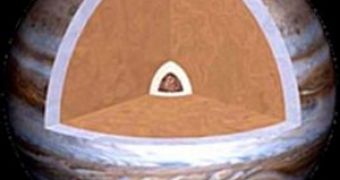A new research performed by a team of geophysicists from the University of California in Berkeley, led by Burkhard Militzer, concluded that the rocky core of the giant gaseous planet in the middle of our solar system is at least twice bigger than previously indicated by computer simulations and studies. The main focus of the study involved the properties of helium and hydrogen atoms within Jupiter when subjected to extreme temperature and pressure.
The data helped the scientists perform a new simulation that indicated the core of the planet is actually somewhat similar to the Earth, except that it's between 14 and 18 times our planet's mass (5% of Jupiter's total mass), which makes it more than twice larger than previously showed. Former theories stated that the gaseous planet's core, if any, should be about seven times the mass of the Earth.
The recent simulation also determined that the Jupiterian core is made of iron and nickel (like the Earth's), mixed up with rocks and layers of ice of methane, ammonia and water types, all wrapped in an atmosphere mostly made of helium and hydrogen.
"Our simulations show there is a big rocky object in the center surrounded by an ice layer and hardly any ice elsewhere in the planet," explained Militzer, quoted by Space. "This is a very different result for the interior structure of Jupiter than other recent models, which predict a relatively small or hardly any core and a mixture of ices throughout the atmosphere." The core was also indicated to have formed about 4.5 billion years ago following the collision of tiny rocks which stuck together and captured the thick atmosphere.
"According to the core accretion model, as the original planetary nebula cooled, planetesimals collided and stuck together in a runaway effect that formed planet cores. If true, this implies that the planets have large cores, which is what the simulation predicts. It is more difficult to make a planet with a small core," shared Militzer. This theory is the complete opposite of the one suggesting Jupiter condensed from a collapsing dust and gas cloud. But until a probe actually checks the situation in situ, it's all very uncertain.

 14 DAY TRIAL //
14 DAY TRIAL //